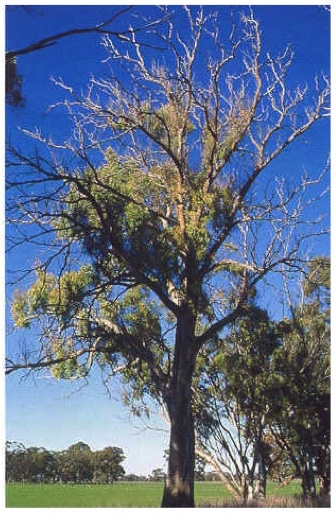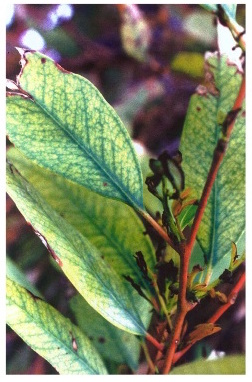PESTS AND DISEASES OF FORESTRY IN NEW ZEALAND
Mundulla Yellows
Scion is the leading provider of forest-related knowledge in New Zealand
Formerly known as the Forest Research Institute, Scion has been a leader in research relating to forest health for over 50 years. The Rotorua-based Crown Research Institute continues to provide science that will protect all forests from damage caused by insect pests, pathogens and weeds. The information presented below arises from these research activities.
From Forest Health News 148, February 2005.
Finding the cause of a new disease when there is no easily recognisable primary pathogen can be a lengthy process. Possible agents must be critically evaluated and many are eventually eliminated as information steadily accumulates. One such disorder is Mundulla yellows, a mysterious ailment of many species of eucalypts and some other species of native flora in Australia.

Symptoms are expressed as a progressive yellowing of the foliage followed by dieback of the crown, and eventually the death of badly affected trees. Leaves exhibit a characteristic interveinal yellowing or chlorosis, which usually starts in the new growth and spreads to older leaves. These symptoms often begin on a single branch before spreading to multiple limbs. New, initially healthy, recovery shoots (referred to as epicormic ‘panic’ growth) may be produced within the tree crown, and this is followed by reduced flowering and seed set. Progression through the various stages may take several years or even decades, ending ultimately in extensive dieback and tree death.
Mundulla yellows is acknowledged as a real threat to the natural biodiversity of many wildlife habitats in Australia. It was named after the town of Mundulla in South Australia where it was first described in 1975, but symptoms have now been found in all States. Since investigations into the disease began fungi, bacteria, and nematodes have all been eliminated as the cause of the problem. Researchers then turned their attention to microscopic agents that cannot live or replicate outside the host plant, such as viruses, viroids (virus-like agents), and phytoplasmas (minute bacteria-like micro-organisms lacking a normal cell wall), and it was soon discovered that a viroid was frequently present within the affected leaf tissues. However, such an association is not proof, and to establish that an agent present within the host is the actual cause of a disease requires a rigorous series of steps to test its virulence or pathogenicity. In the case of Mundulla yellows different groups of researchers have reported a variety of results and the role of this viroid in the development of the disease remains a matter of contention. Other possible causes have been considered, including the likelihood that the symptoms may develop after the roots on affected trees have absorbed certain herbicides applied to control weed growth. One multidisciplinary group of researchers in Victoria and South Australia have identified some factors common to sites associated with the disorder. They found a strong and consistent relationship with high pH alkaline soils, low levels of iron and manganese in the soil and plant, and high rates of carbonates and chloride in the foliage. They postulate that habitat modification may be the primary cause of the condition. Many parts of Australia are experiencing serious vegetation problems due to increased soil salinity. This is a result of rising water tables following the change from the natural landscape of woodlands and shrublands to pasture and agriculture.

Thus 30 years after the recognition of Mundulla yellows as a new disease the definitive cause or causes have not been unequivocally established. Research is continuing but it may still be some time before there is a final answer to the cause of Mundulla yellows.
For further information, visit sites such as:
http://www.environment.gov.au/biodiversity/invasive-species/diseases-fungi-and-parasites/mundulla-yellows
https://www.burkesbackyard.com.au/fact-sheets/in-the-garden/weeds-and-garden-pests/mundulla-yellows/
(Margaret Dick, Forest Research, from information provided by
Ian Smith, Department of Sustainability and Environment,
Forest Pathology, Heidelberg, Victoria, Australia)
This information is intended for general interest only. It is not intended to be a substitute for specific specialist advice on any matter and should not be relied on for that purpose. Scion will not be liable for any direct, indirect, incidental, special, consequential or exemplary damages, loss of profits, or any other intangible losses that result from using the information provided on this site.
(Scion is the trading name of the New Zealand Forest Research Institute Limited.)

 Farm Forestry New Zealand
Farm Forestry New Zealand

